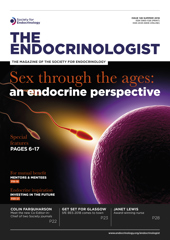The field of fertility preservation is an example of how advances in one area of clinical medicine can have a direct impact on the quality of care in another. It also shows some of the challenges when we attempt to work across traditional disciplines and boundaries. While everyone tries to do their best for the patient in front of them, awareness of options and ease of referral pathways can make all the difference to whether patients are offered, and take up, the option of preserving their fertility.
Fertility preservation applies to both men and women. We see individuals faced with the prospect of losing their fertility for medical reasons, as well as those who are medically well, but wish to take measures to preserve the option of parenthood at a later stage of their lives (so-called ‘social fertility preservation’).
While social egg freezing, in particular, has attracted a lot of media attention, the more immediate challenge for the NHS is to set up pathways for fertility preservation in individuals where either their diagnosis or their proposed treatment threatens harm to fertility, and time is of the essence.
CASES WITH A MEDICAL NEED
The largest group of patients in this category are those diagnosed with cancer, who face the prospect of damage to their fertility as a result of chemotherapy, radiotherapy or surgery. As survival rates from cancer have improved, the quality of life for survivors has come into focus. It is known that cancer survivors rate loss of fertility as the most distressing outcome of cancer treatment.
There are also situations outside oncology where patients’ fertility may be at risk, such as stem cell transplantation in individuals with sickle cell anaemia. Individuals transitioning from one gender to another may wish to retain the possibility of genetic parenthood.
The likelihood of damage is related to the age of the patient, and the type and dose of chemotherapy and radiotherapy. For instance, alkylating agents and pelvic radiotherapy present a high risk of leading to ovarian follicular depletion, while anthracyclines have a low risk. Abdomino-pelvic radiation in excess of 24 gray is associated with complete ovarian failure. Cranial radiotherapy can lead to impaired hypothalamo-pituitary-gonadal function, although the ovarian follicular pool may not be affected.
This means that the risk of subsequent infertility needs to be assessed on an individual basis for each patient. It is appropriate for fertility preservation to be discussed at an early stage of the treatment process. Whether or not it is offered as a treatment option depends on whether the cancer treatment is curative in intent, the risk to fertility from treatment, the fitness of the patient to undergo ovarian stimulation and egg retrieval and, finally, the possible effect of a delay in starting cancer treatment on the prognosis.
OVARIAN STIMULATION
Within reproductive medicine, ovarian stimulation regimes now exist that can minimise the delay and risk associated with this process. Specifically, we now know that we can start ovarian stimulation at any point in the menstrual cycle, using the gonadotrophin-releasing hormone (GnRH) antagonist to prevent an endogenous luteinising hormone (LH) rise. In women receiving GnRH antagonist, the pituitary retains its sensitivity to GnRH. This property allows us to use a single dose of GnRH agonist as a trigger for final follicular maturation in women on the antagonist. The agonist trigger causes an endogenous surge of LH (and follicle-stimulating hormone), which is sufficient to obtain mature eggs for fertilisation or vitrification. In comparison with the traditional trigger of human chorionic gonadotrophin, GnRH agonist is associated with a much lower risk of ovarian hyperstimulation syndrome, making this a safer option for patients who need to get on with their cancer treatment.
EMBRYO CRYOPRESERVATION VS OOCYTE VITRIFICATION
The most established technique to preserve fertility in women is embryo cryopreservation, but this of course requires the presence of a male partner. Future use of embryos requires both partners to consent to their use at that time, and hence careful counselling is required before choosing this option. In recent years, the development of oocyte vitrification as a viable laboratory technique now allows women to store their unfertilised eggs and obviates the need for a male partner or future consent. Live birth rates from vitrified–warmed eggs are comparable with those from ‘fresh’ eggs, though the data are mainly from egg donors rather than cancer patients.
PREPUBERTAL OPTIONS
Fertility preservation options for prepubertal girls and boys are still relatively less developed, but progress has been made in ovarian tissue cryopreservation. It is sensible to consider this still as an experimental treatment that requires a licensed laboratory and should be delivered in a research setting. The hope is that this will become a viable option for prepubertal girls and also for older girls and women where even the short delay for ovarian stimulation is contraindicated. Stored ovarian tissue can be transplanted into the ovarian fossa (‘orthotopic’) or elsewhere (‘heterotopic’). Orthotopic transplantation keeps open the possibility of natural conception.
MEN AND BOYS
I have not discussed here the options available for men and boys needing to preserve their fertility. However, the general principles of need and appropriateness apply equally to them. Sperm cryopreservation is an established and successful method and widely available in the NHS. In contrast, options for prepubertal boys are experimental, although exciting laboratory work is occurring in in vitro spermatogenesis, using frozen– thawed testicular tissue. Like other fast-moving and complex areas, fertility preservation requires clinicians to be aware of their options and local pathways, so that they can offer their patient the best advice. For interested colleagues, the British Fertility Society has set up a Fertility Preservation Special Interest Group (www.britishfertilitysociety.org.uk/special-interest-groups/ fertility-preservation-uk) and has also published peer-reviewed guidelines dealing with these issues.1
Raj Mathur, Consultant Gynaecologist and Subspecialist in Reproductive Medicine and Surgery, Manchester University NHS Foundation Trust
REFERENCE
- Yasmin E et al. 2018 Human Fertility 21 3–26.






